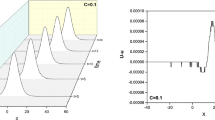Abstract
The hybrid finite analytic (HFA) method is a kind of numerical scheme in rectangular element. In order to simulate the shallow circulation in irregular bathymetry by HFA scheme, the model in sigma coordinate system was obtained. The model has been tested against three cases: 1) Wind induced circulation; 2) Density driven circulation and 3) Seiche oscillation. The results obtained in the present study compare well with those obtained from the corresponding analytical solutions under idealized for the above three cases. The hybrid finite analytic method and the circulation model in sigma coordinate system can be used calculate the flow and water quality in estuaries and coastal waters.
Similar content being viewed by others
References
Komatsu T, Kohashi N, Park D. Improvement of water quality in a sea area by activating substance transport using bottom roughness[A]. In: Odgaard, Jacob Ed.Proceedings of 4th International Conference of Hydroinformations[C]. New York: Press Jessup Holl, 2000, 653–658.
Liggett J A, Hadjitheodorou C. Circulation in shallow homogeneous lakes[J].J Hydraulics Division, ASCE, 1969,95 (3): 609–620.
Swanson J C. A three dimensional numerical model system of coastal circulation and water quality [D]. PhD dissertation. Kingstion R I: University of Rhode Island, 1986.
Blumberg A F, Mellor G L. A description of a three-dimensional coastal ocean model[A]. In: N S Heaps Ed.Three-Dimensional Coastal Ocean Models [C]. Washington, D C: America Geophysical Union, 1987, 79–91.
Sheng Peter Y. On modeling three-dimensional estuarine and marine hydrodynamics[A]. In: Nihoul J C J, Jamart B M Eds.Three Dimensional Model of Marine and Estuarine Dynamics [C]. New York: Elsevior, 1987, 35–54.
HANG Wen-rui, Spaulding M. 3D model of estuarine circulation and water quality induced by surface discharges[J].J Hydraulic Engineering, 1995,121 (3): 300–311.
Kim C, Li J. A three dimensional PC-based hydrodynamic model using an ADI scheme[J].Coastal Engineering, 1995,23 (2): 271–287.
Shankar N J, Cheong H F, Sankaranarayanan S. Multilevel finite-difference model for three-dimensional hydrodynamic circulation[J].Ocean Engineering, 1997,24(3): 785–816.
Philips N A. A coordinate system having some special advantages for numerical forecasting[J].J Meteorology, 1957,14 (1): 184–185.
LI Wei, HUAI Wen-xin. Calculation of whole field for vertical round buoyant jets in stratified environment [J].J Hydraulic Research, 1997,33 (6): 865–876.
Officer C B.Physical Oceanography of Estuaries (and Associated Coastal Waters) [M]. New York: John Wiley and Sons, 1976.
Neumann G, Pierson W J.Principles of Physical Oceanography [M] Englewood Cliffs, N J: Prentice Hall Inc, 1966.
Author information
Authors and Affiliations
Additional information
Communicated by Lupin Jian-zhong
Foundation item: the Foundation for University Key Teacher by the Ministry of Education of PRC (430016)
Biography: Hupuai Wen-xin (1963∼), Professor, Doctor (E-mail: emwxhuai@wuhee.edu.cn)
Rights and permissions
About this article
Cite this article
Wen-xin, H., Peter Sheng, Y. & Komatsu, T. Hybrid finite analytic solutions of shallow water circulation. Appl Math Mech 24, 1081–1088 (2003). https://doi.org/10.1007/BF02437640
Received:
Revised:
Issue Date:
DOI: https://doi.org/10.1007/BF02437640




